Summary
- Animal activists have various motivations to help animals, but the majority of them agree that animals should not suffer.
- Suffering is difficult to measure and define, but it is important to try to do so, as it allows us to prioritize which animals need the most help. One approach is to define different intensities of suffering (excruciating, disabling, hurtful, and annoying), and then to look at the number of hours that animals spend in each one of these different states. Ultimately, the two critical components of suffering are its duration and intensity.
- The number of animals killed alone is not a sufficiently precise proxy for the time they spend in farms or their average suffering, making it inadequate for prioritizing between different species.
- Improving welfare conditions and reducing the number of animals farmed both play significant roles in decreasing the total amount of suffering, although they impact different aspects of the suffering equation (intensity vs. duration).
- For animals like broiler chickens and egg-laying hens, reforms such as adopting European Chicken Commitment standards and cage-free systems significantly reduce suffering.
The challenge of understanding the scope of animal suffering
The injustice of animal farming is inconceivable. By the time you’re done reading this post, more than 1 million broiler chickens will have been slaughtered. At the exact moment these lines are written, around 100 billion fishes live in horrendous conditions in farms around the globe. The overwhelming scale of the problem is the main driver for most activists – we’re in constant triage and we want to help animals as much as possible with our limited resources. However, the scale of this problem can also deceive us if we are not careful enough.
One well-known challenge in this context is scope insensitivity – the human brain struggles to grasp the magnitude of problems relative to their size. Despite this, it seems that modern animal advocates demonstrate a relatively strong ability to distinguish differences in vast numbers. They tend to prioritize farmed animals over companion animals, or farmed chickens over many other species of farmed animals. However, advocates must consider another potential pitfall when assessing scope – fixating solely on the number of animals killed while ignoring other crucial considerations, such as suffering.
To illustrate the moral significance of this distinction, we will use an imaginary example of two animals. Please note that it will include some description of animal suffering and death (as we will do in other parts of the article). Let’s imagine two dogs – Alan and Nala. Both of them were just diagnosed with an identical terminal and aggressive cancer. Their lives from that point on will be filled with unmanageable, excruciating pain. After careful consideration and observation, Alan was euthanized by the vet after one month. Unfortunately, Nala was living with an impoverished family that had no resources to afford veterinary care, and thus the procedure was delayed by 11 months. In this example, both dogs were euthanized within a year, so the number of animals who died within the year is two. However, both intuitively and in most moral frameworks, we can clearly tell the difference between the quality of their lives and we wouldn’t hesitate to choose one option over the other for our own dog. Considering the quality of their lives as equal just because they were both euthanized will make us overlook important contextual factors.
While there are arguments in favor of focusing on goals other than just the scale of suffering, in most worldviews, accurately capturing it will be instrumental to such goals.
Can suffering even be measured?
While it is really unclear if it will ever be possible to capture the suffering of a sentient being in numbers alone, we think we can provide a framework that is sufficiently satisfying and decision-relevant. Despite its limitations, it represents the best approach available to us at present, allowing us to make more informed decisions for animals. We will also need to look at the suffering in a very down-to-earth, emotionless way to understand it well.
Consider a caged laying hen, for instance. Her life is spent in unimaginable suffering – keel bone fractures, skin wounds, cannibalism, deprived of the ability to nest, and forage, crammed in a tight space without access to sun or fresh air, and unable to ever walk on the grass. As difficult as it may be, is it possible to measure her suffering to be able to help her better?
The Welfare Footprint Project created a useful framework for trying to solve this difficult issue. They use four categories of pain, from the least to the most intense:[1]
- annoying pain,
- hurtful pain,
- disabling pain,
- excruciating pain.
For instance, they conclude that throughout her life, and due to the terrible conditions described above, a battery-caged hen[2] will endure on average at least 3 minutes of excruciating pain, 431 hours of disabling pain, 4,054 hours of hurtful pain, and 6,721 hours of annoying pain.
We see that two critical components matter here: the duration of the suffering of the hen and its intensity. Note that the Welfare Footprint Project uses four categories of suffering. This is because there are deep uncertainties associated with converting them into one single unit. Is one minute of excruciating pain 10 times worse than 1 minute of disabling pain? 1,000 times worse? These are hard and deeply troubling questions.[3]
A rigorous approach would therefore be to consider that the total amount of suffering endured by an animal throughout their life is equal to the number of hours of excruciating pain the animal experienced, the number of hours of disabling pain, the number of hours of hurtful pain, and the number of hours of annoying pain, without converting these different suffering intensities into a single common unit. Keeping that in mind, and for simplicity’s sake within the purpose of this article, we will assume that the total amount of suffering an animal experiences over the course of its life is equal to its lifespan multiplied by the average intensity of its suffering.
That is:
Total suffering = Duration of the suffering × Average intensity of the suffering.
We can now apply this framework in an attempt to find out which animals suffer the most, and thus need the most help. We’ll see that common metrics, such as the number of animals killed, are not the only relevant ones when it comes to measuring suffering.
Deciding which species to help: looking beyond the number of animals killed
The prioritization problem
Let’s consider the following scenario: we have two different species of farmed animals, Species A and Species B. Determining which species suffers more overall is essential, considering that it will be the one that needs the most help.[4]
Following what is written above, we’d say that Species A suffers more than Species B overall if the product of:
- the average intensity of suffering of the animals of the species, and
- the time the animals of the species cumulatively spend in farms, transport, and slaughterhouses every year (in the rest of the article, we’ll just write “time spent in farms”)
is greater for Species A than for Species B.
So, in order to prioritize between species A and B, one needs to estimate the average intensity of suffering and the total time spent in farms for each species.
Estimating the total time animals spend in farms
To arrive at the total time spent in farms by all animals of a species in a year, we multiply the number of animals killed each year by their average slaughter age.
For instance, if 1,000 hens are killed every year in a given country, with an average slaughter age of 17 months, they cumulatively spend 1,000×17×30=510,000 days in farms every year. The time spent by a species in farms therefore depends on two parameters: the number of animals of the species killed and their average slaughter age.
Why does it matter? Because it shows that the number of animals killed doesn’t give us full information about the time they spent in farms. We also need to know at what age they are killed.
As an example, in France (the author’s country), the average lifespan of an egg-laying hen is 17 months and the average lifespan of a standard broiler chicken is 35 days. 17 months is approximately 15 times longer than 35 days. This means that a hen will spend 15 times more time on a farm than a broiler chicken.
With that in mind, let’s imagine a hypothetical farm that always has exactly one broiler chicken and one laying hen at any given time. After 35 days, the first broiler is slaughtered and replaced by a second one. 35 days later, the second broiler is also slaughtered, replaced by a third one, and so on. This continues until the end of the 17th month, which is when both the 15th broiler and the hen are slaughtered.
Throughout this period, the broilers will have cumulatively spent a total of 17 months in the farm. The hen will also have spent a total of 17 months in the farm. However, 15 broilers have been killed in the process, for “only” one hen. See the picture below.
This means that it’s possible that more animals of Species A are killed annually than of Species B, but Species B might still have spent more time being farmed than Species A because it has a higher slaughter age.
Also note that to compare the total time spent in farms by Species A and B, we can just compare the number of animals of these species that are alive at any point in time. This is because the total number of days lived in a year by the animals of a species is also equal to the number of animals of this species alive at any point in time multiplied by 365.
Staying with our previous example, if 1,000 hens are killed every year in a given country, with an average slaughter age of 17 months, we saw that they cumulatively spend 510,000 days in farms during every year. To calculate the number of hens alive at any point in time, we have to divide this number by 365. The result is that 1,397 hens are alive at any point in time in this country.
This makes it easier to compare the total time spent in farms by all animals of each species within a year. It’s also a more straightforward way for people to grasp the concept. Saying something like, “Right now, there are about 13 million hens confined in cages in our country. This is unacceptable!” makes the issue more relatable, for instance in the context of a cage-free corporate campaign.
Example: comparing the numbers of farmed animals of different species alive in France
As shown above, in order to compare which species spend the most time in farms, we just have to compare how many animals from these species are alive in farms at any point in time. Let’s look at some commonly farmed animals in France. We use the official statistics[5] for the numbers of animals killed and their average slaughter age. We then multiply these two quantities and divide by 365, as shown above. We find that:
- 780 million broilers are killed each year with an average slaughter age of 44 days ➡️ 94 million broilers are alive at any time in French farms.
- 41 million farmed trout are killed each year for human consumption with an average slaughter age of 12.7 months (with some uncertainty about the age of slaughter) ➡️ 43 million trout are alive at any time in French farms.
- 40 million laying hens are killed each year with an average slaughter age of 17 months ➡️ 56 million laying hens are alive at any time in French farms.
- 23 million pigs are killed each year with an average slaughter age of 6 months ➡️ 11 million pigs are alive at any time in French farms.
We see that the proportion between the numbers of animals killed is quite different from the proportion between the numbers of animals alive at any point in time. The graphic below illustrates it:
From this example we can learn that to understand animal suffering it’s important to calculate the number of animals alive at any given point in time, not just the number of animals killed.
Estimating the average intensity of suffering
Estimating the average intensity of suffering experienced by animals seems much harder than estimating the time they spend in farms. One should probably rely on expert studies, like the Welfare Footprint Project’s. Sadly, such studies aren’t available for many species as the well-being of animals is usually ignored if it has no relevance for economic gains.
Without precise information, it is tempting to put a large weight on the slaughter of animals as a strong contributing factor to all the suffering they endure. And thus, to think that animals that are killed in the largest numbers are probably the ones who suffer the most on average.
We would like to urge caution here. The manner in which animals are slaughtered is indeed often atrociously cruel and painful. More than one activist has started their journey after watching a video showing what happens in slaughterhouses. However, remember that compared to the whole life of the animal, slaughter is very brief. Furthermore, while it’s easier for humans to empathize with an animal’s struggle for survival in a slaughterhouse, our empathy is not well calibrated to understand the ongoing suffering animals endure while living on a factory farm. For example, we may underestimate how distressing it is for a hen to be deprived of her ability to express her natural behaviors such as nesting and dust-bathing, or how common terribly painful injuries such as keel bone fractures are in farms. Thus, even if slaughter is horribly painful and vivid, it might ultimately represent only a small portion of all the suffering an animal is forced to experience. Two examples show that this might be the case for commonly farmed animals.
1. The Welfare Footprint Project quantified the number of hours of suffering experienced by a conventional broiler due to harms such as lameness, behavioral deprivation, cardiac conditions and thermal stress throughout the animal’s life. They found that a broiler would suffer on average at least 30 seconds of “excruciating pain,” 50 hours of “disabling pain,” 333 hours of “hurtful pain,” and 324 hours of “annoying pain” due to these issues. The worst slaughter method would cause the average broiler to suffer an additional 6 seconds of excruciating pain and 93 seconds of disabling pain. So even if broilers have a very short lifespan, their slaughter only accounts for a small portion of all the suffering they endure, even the most intense types of suffering.
2. Rethink Priorities recently estimated the “Prospective cost-effectiveness of farmed fish stunning corporate commitments in Europe.” This intervention aims to reduce the suffering fish experience during their slaughter. Here are some conclusions of this study:
- “While this intervention could potentially affect 2 to 36 fish per dollar spent, the short duration of fish slaughter means this is equivalent to improving only 0.4 to 10 fish hours per dollar.”
- “The relatively short amount of time affected limits how cost-effective this intervention appears when compared to other promising animal and human interventions, except perhaps under frameworks that prioritize averting short-duration but high-intensity suffering.”[6]
It therefore seems risky to use the number of animals killed of different species as a direct proxy for comparing their average suffering intensities. More extensive research should probably be done if estimating the average suffering intensity is important for your decision-making.
Conclusion about the prioritization problem
Comparing the numbers of animals of Species A and Species B killed in one year may not be, in several cases, a good proxy for comparing either the total time they spent in farms or their average suffering.
It is better, if possible, to directly make an estimate of their respective total time spent in farms and average suffering intensity. For hens and broilers, one may directly apply the estimates from the Welfare Footprint Project.
Now that we have somewhat clarified how to measure animal suffering, we can ask: What can be done to effectively reduce it? We’ve seen that focusing solely on the number of animals killed can be misleading in estimating their suffering. Similarly, focusing only on reducing the number of animals killed to diminish animal suffering might prevent us from helping animals in the best way possible. We will explore this in the next section.
Underestimating how much welfare improvements help animals
In terms of reducing suffering, welfare improvements can be the same thing as reducing the number of animals farmed
Removing animals from farms (by ensuring they are not being born) can seem incommensurably better than reducing their suffering. This post certainly does not deny that decreasing the number of farmed animals is crucial to reducing the suffering of farmed animals. However, it should not prevent us from looking at the suffering from the perspective of the individual animals we want to help. We argue that acknowledging the quality of their lives is crucial in helping them.
This animal-centered view can thus lead us to a conclusion that may be uncomfortable for some of the readers who may be more inclined to advocate for progress for animals unrelated to incremental welfare improvements. Our conclusion is that when it comes to reducing the suffering of farmed animals, the immediate effect of improving animal lives can be considered equally effective as reducing the number of animals farmed. Why is that?
Remember our definition of suffering. That is:
Total suffering = Duration of the suffering × Average intensity of the suffering.
Let’s take all the broilers farmed in the reader’s country, for instance. The equation above shows that dividing by a factor 2 either their number or their average suffering intensity will in both cases divide their total suffering by a factor of 2.
We want to highlight that we’re only talking about the immediate effect here. This article doesn’t aim to analyze the long-term effects of different strategies. It is possible that the long-term effects of reducing the number of animals farmed are better than improving their lives, and the opposite may also be true. What we want to do is mainly to insist that the gains for animals of having their suffering reduced should not be overlooked, even if the number of animals doesn’t change.
But are welfare reforms effective at reducing suffering?
If welfare reforms only decrease the average suffering of farmed animals by a very small amount, they may not be worth working for. But at least for hens and broilers, it does seem that they significantly reduce the suffering these animals experience.
Once again, the Welfare Footprint Project’s numbers will come in handy. They studied the suffering reduction that occurs when producers adopt the European Chicken Commitment[7] for broilers and cage-free systems for hens.
For broilers, they found that compared to a conventional broiler, a broiler raised in ECC standards experiences:
- 81% less excruciating pain (25s less)
- 65% less disabling pain (32h less)
- 23% less hurtful pain (78h less)
- 5% more annoying pain (15h more)
For hens, they found that compared to a battery-caged hen, a cage-free hen experiences:
- 20% less excruciating pain (36s less)
- 64% less disabling pain (275h less)
- 57% less hurtful pain (2,314h less)
- 69% less annoying pain (4,645h less)
As you can see, at least for hens and broilers, welfare reforms massively reduce the suffering of farmed animals. It can therefore be argued that they are qualitatively the same thing as reducing the number of farmed animals, especially if we take an animal-centered approach that wants to reduce the suffering that individuals are forced to experience.
Conclusion
In Anima International, we strongly believe that not understanding the nuances of animal lives can blind us to the harm we want to fix. In this article, we seek to discuss the important implications of focusing on reducing animal suffering. Our aim isn’t to determine the most effective type of campaign for this goal. Rather, to provide some tools that help assess how well different interventions mitigate animal suffering.
We encourage advocates to consider not only the number of animals killed but also the duration of their suffering. Similarly, we welcome focus on what reduces not only the scale of animal farming but also the intensity of animal suffering. Ultimately, we invite readers who are trying to choose an approach to animal advocacy to keep in mind the different factors that come into play when it comes to reducing animal suffering.
Acknowledgements:
Cynthia Schuck-Paim (Welfare Footprint Project), Gautier Riberolles (Welfarm), Jakub Stencel, Anna Kozłowska, Kirsty Henderson, Connor Jackson, Jan Sorgenfrei, Laura Gough (Anima International).
Photo : Andrew Skowron and Aleksandr Askirka
Graphic design: Katarzyna Sokołowska (Anima International).
All mistakes and inaccuracies are Anima International’s.
- ^
See the Welfare Footprint Project webpage for definitions.
- ^
The Welfare Footprint Project also provides estimates for furnished cages (battery cages are banned in the EU). However, a majority of hens in Latin America and Asia-Oceania are still kept in battery cages (see https://www.wattagnet.com/egg/egg-production/article/15535764/how-laying-hens-are-kept-around-the-world).
- ^
For more see https://forum.effectivealtruism.org/posts/C2qiY9hwH3Xuirce3/short-agony-or-long-ache-comparing-sources-of-suffering-that
- ^
Within the “importance, tractability, and neglectedness framework”, assessing overall suffering of each species informs the “importance” parameter. Please note that this article does not aim to assess which strategies are the best for helping animals according to this framework, but rather to specify precisely what “helping animals” means if you want to reduce their suffering. That’s why this article will only be useful for assessing the “importance” parameter in the ITN framework.
- ^
https://agreste.agriculture.gouv.fr/agreste-web/download/publication/publie/Chd2319/cd2023-19_SAA2022-D%C3%A9finitive.pdf
- ^
As written in Rethink Priorities’ report, it is worth noting, though, that these estimates depend on how you compare short but extremely severe suffering to longer but less intense suffering. As mentioned earlier, these are difficult questions. We refer again to the article from the Welfare Footprint Project – https://forum.effectivealtruism.org/posts/C2qiY9hwH3Xuirce3/short-agony-or-long-ache-comparing-sources-of-suffering-that
- ^
The Welfare Footprint Project estimates that their results are valid for both the European and the Better Chicken Commitment, as they are both very similar. Their estimates are based on reports/studies of the prevalence of welfare issues both from Europe and the US (in fact, predominantly from Europe, since US data is very scarce). Thus, if anything, the estimated welfare gains in their work are more likely to reflect the European rather than the US situation. In other words, suffering averted in the US, due to the welfare issues analysis, could be higher than what they estimated.

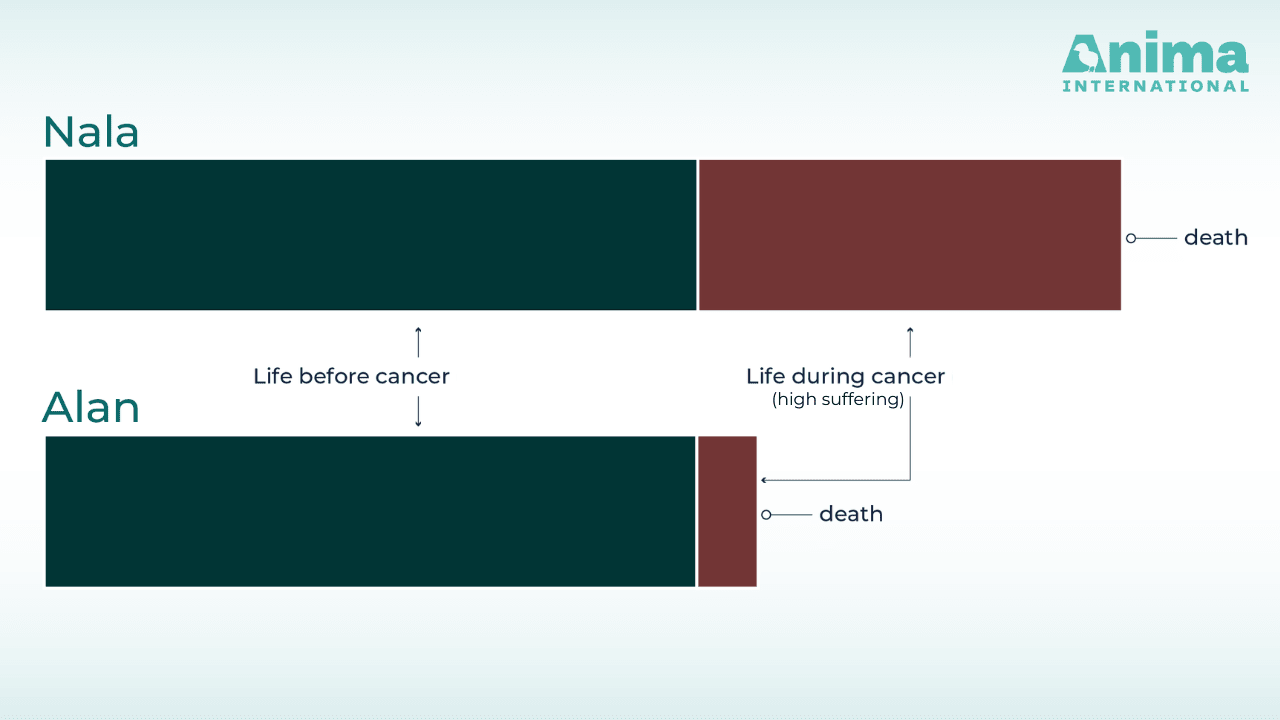
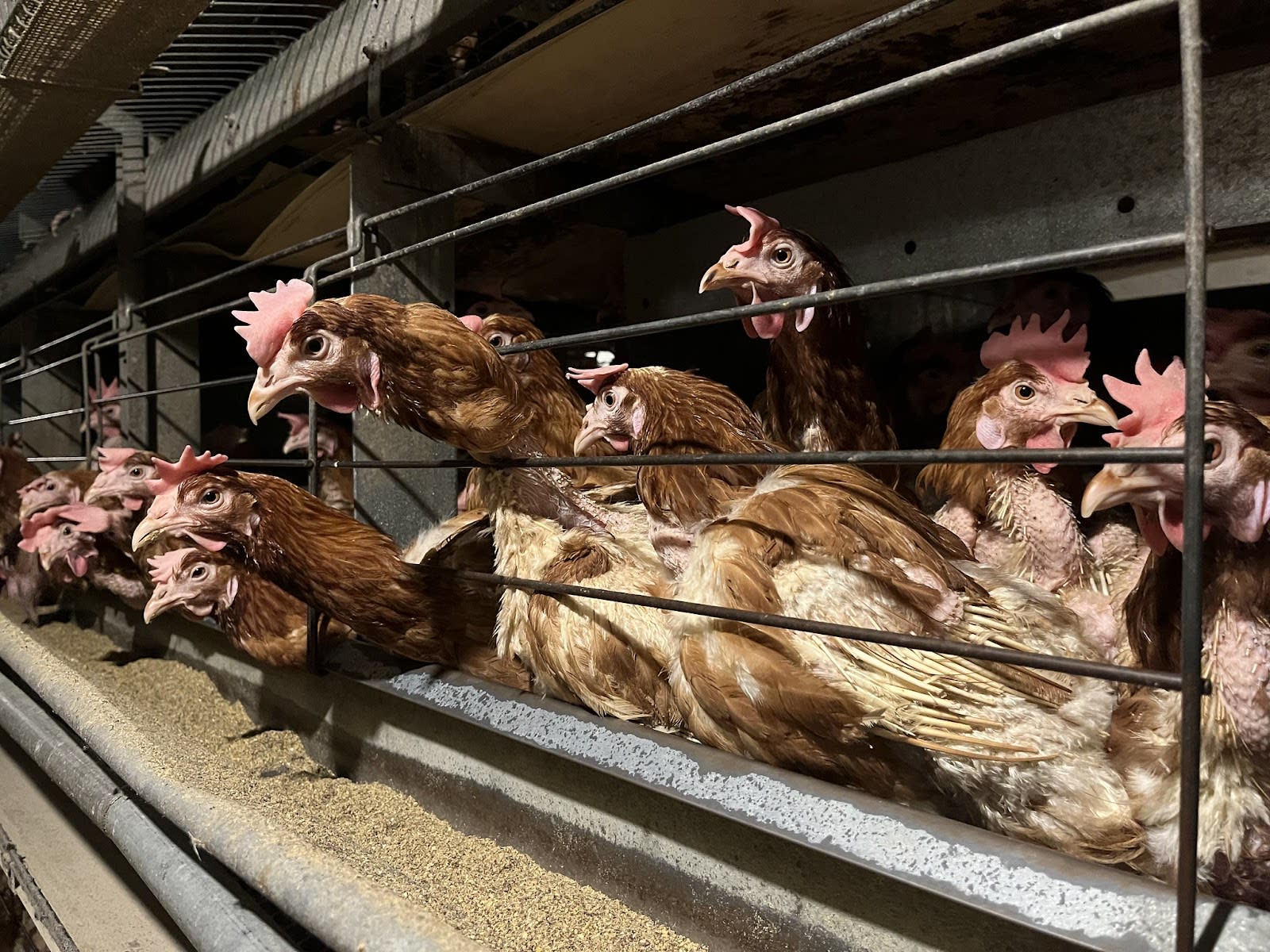
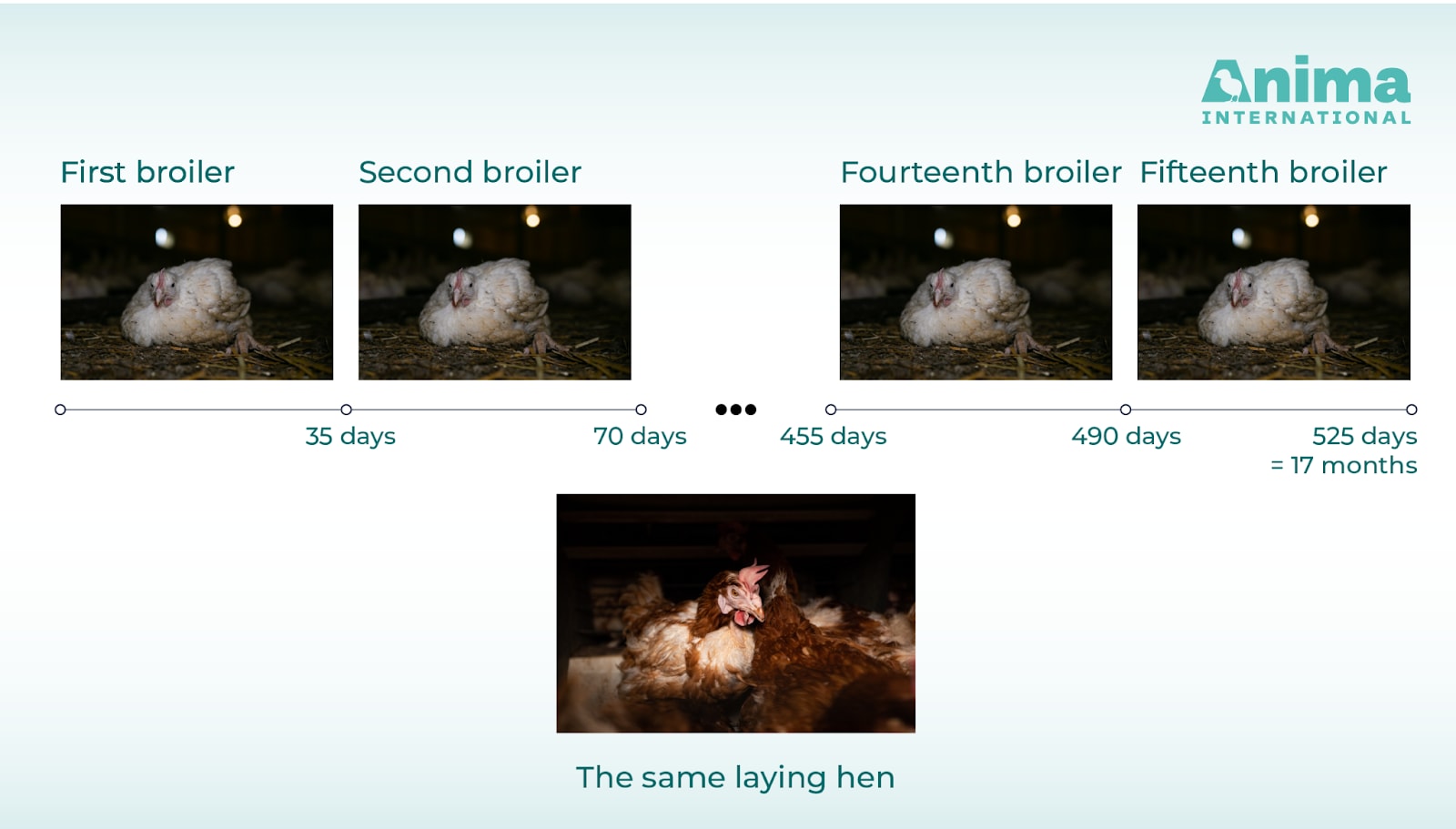
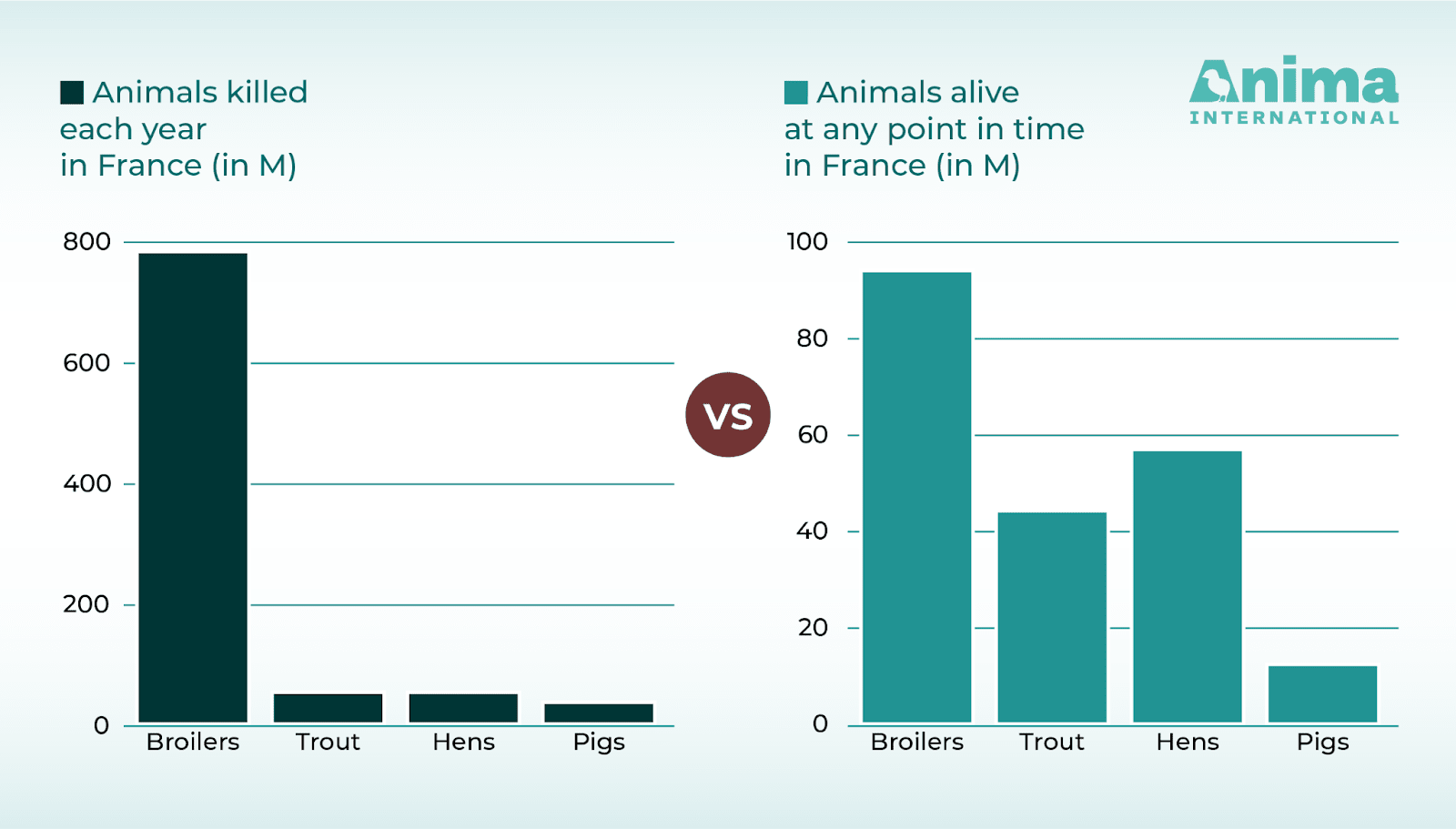
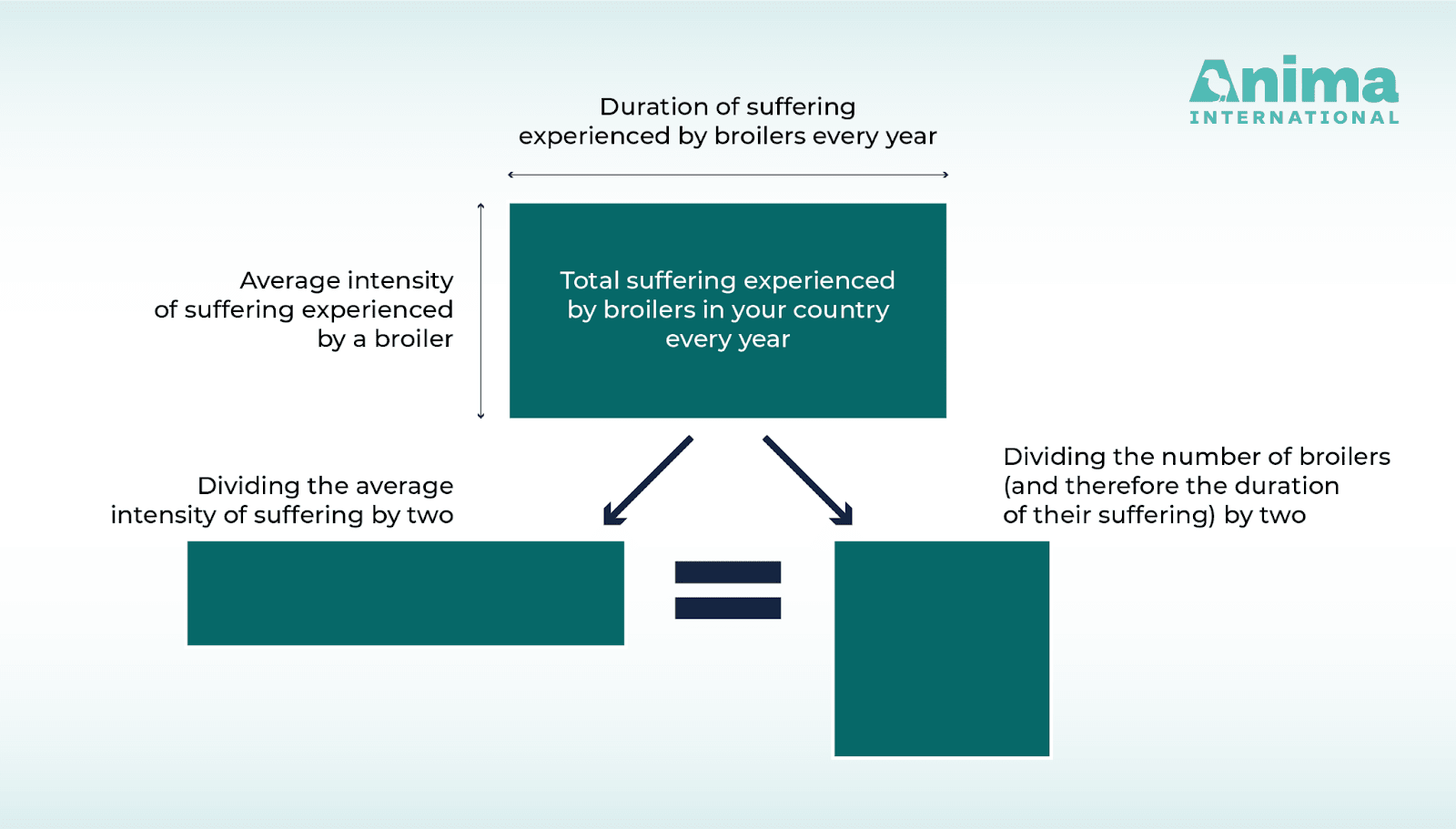
Nice post, Keyvan!
I have Fermi estimated the scale of the suffering of the various populations of farmed animals, assuming the intensity of suffering relative to the welfare range for all populations matches that of broilers in reformed scenarios. In agreement with Open Philanthropy's prioritisation, I calculated farmed chickens and fish are the 2 populations with the most suffering, with a scale equal to 1.74 and 1.52 times that of the happiness of all humans (which highlights the meat eater problem). Farmed shrimps and prawns came in 3rd, with a suffering whose scale is 1.05 times that of the happiness of all humans.
Another good example of the difference between the number of animals killed and the number of animals alive at any point in time is with shrimps and insects. This report (Shrimp: The animals most commonly used and killed for food production, see figures 1 and 2) from Rethink Priorities estimated that in 2020 :
(Note that the number of insects farmed may have increased since 2020)
Thanks @William McAuliffe for pointing that out to me.
Hi Keyvan,
Here are some related notes. For a given group of farmed animals (the 2 1st points are the ones that matter):
Annual suffering is inversely proportional to the supply per living time. So, everything else equal, it would be good to have broilers which grow faster, and hens which lay eggs more frequently. Unfortunately, everything else is not equal, as higher supply per living time tens to be associated with more suffering per living time. I estimate the suffering per living time of broilers in a reformed scenario is 18.3 % that of ones in a conventional scenario, whereas the ones in a conventional scenario grow 74.6 %[1] (= (45 + 46)/(60 + 62)) as fast as ones in a conventional scenario. So, instead of the final annual suffering being 18.3 % the initial one, it is 24.5 % (= 0.183/0.746) because of the increase in the number of broilers need to sustain a given meat supply. This ratio is still much lower than 1, so moving broilers from conventional to reformed scenarios is robustly good even accounting for the resulting increase in the number of broilers.
Ratio between the means of the lower and upper bounds provided by the Welfare Footprint Project.
Executive summary: Accurately quantifying animal suffering requires considering both the duration and intensity of their pain, revealing that focusing solely on the number of animals killed can obscure the true extent of their suffering.
Key points:
This comment was auto-generated by the EA Forum Team. Feel free to point out issues with this summary by replying to the comment, and contact us if you have feedback.